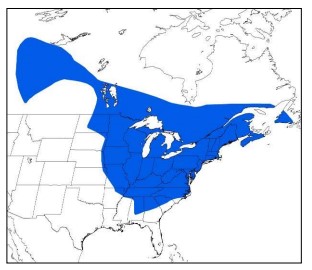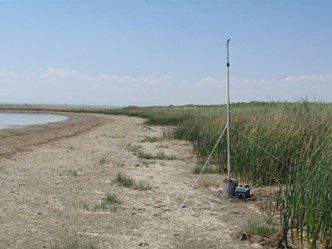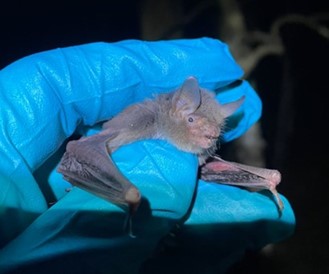The information contained in this article is not intended as legal advice and may no longer be accurate due to changes in the law. Consult NHMA's legal services or your municipal attorney.
New Hampshire is home to numerous wildlife species, many of which are protected under the federal Endangered Species Act. The northern long-eared bat (NLEB) is the latest native species to be reclassified as endangered, requiring additional impact assessments, regulatory consultation and mitigation measures. Several recent projects in NH have navigated this new process to avoid potential delays in project development and construction. Additional site assessments of adjacent structures to identify any existing roosting locations can help provide valuable information, and acoustic surveys can be used to demonstrate the probable absence of the NLEB in many cases. Understanding these process changes and additional mitigation measures will help local projects stay on schedule while considering the NLEB, especially if your project is funded or approved by a federal agency.
Threatened and Endangered Species Update
The northern long-eared bat (Myotis septentrionalis; NLEB) has been reclassified from threatened to endangered by the U.S. Fish and Wildlife Service (USFWS) under the Endangered Species Act (ESA; 16 U.S.C. § 1531 et seq.). Listed as threatened in 2015, the NLEB is endangered with extinction largely due to white nose syndrome, a disease caused by an introduced fungal pathogen that has decimated the NLEB population. Other threats to this species include wind turbines, loss of summer habitat, and loss or disturbance to winter hibernating habitat. NLEB is a far-ranging species occurring across 37 states in a variety of habitat types and projects across this footprint must consider impacts to this newly endangered species.
 Geographic range of the northern long-eared bat .
Geographic range of the northern long-eared bat .
Source: https://www.vhb.com/reclassification-northern-long-eared-bat/
The Endangered Species Act (ESA) of 1973 is the primary law in the United States for protecting imperiled species. Section 7 of the ESA requires federal agencies (also referred to as the action agencies) to ensure that actions they undertake, authorize via permits, or fund (resulting in federal nexus) are not likely to jeopardize threatened or endangered species or adversely impact any designated critical habitat. Projects that lack a federal nexus are exempt from the ESA Section 7 consultation requirements. However, since no entity is exempt from the ESA Section 9 take[1] prohibitions for federally listed species, applicants for projects that lack a federal nexus may choose to voluntarily consult with the USFWS to have authorization for incidental take that may occur as a result of the proposed action.
The final rule classifying the NLEB as endangered went into effect on March 31, 2023. Preceding the effective date of the ruling, the USFWS released new tools and resources to aid stakeholders in assessing project impacts to NLEB. The online Information for Planning and Consultation (IPaC) System has Determination Keys (DKeys) that streamline consultations for projects that qualify for a predetermined consultation outcome based on a USFWS Programmatic Biological Opinion or Standing Analysis.
Tools and Resources for Assessing Project Impacts
The FHWA, FRA, FTA Programmatic Consultation for Transportation Projects affecting NLEB or Indiana Bat would be used to conduct the ESA Section 7 Consultation. This DKey only verifies a project’s compliance with the USFWS Programmatic Biological Opinion for Transportation Projects in the Range of the Indiana Bat and Northern Long-Eared Bat (dated February 2018, amended March 23, 2023).
For projects that are funded or authorized by a federal agency other than the FHWA, FRA, or FTA (such as the US Army Corps of Engineers), the Northern Long-Eared Bat Rangewide Determination Key would be used to help determine if the proposed action has the potential to adversely affect the NLEB. This DKey covers a variety of routine and predictable projects for which predetermined consultation outcomes are feasible based on the USFWS Standing Analysis and Implementation Plan – Northern Long-Eared Bat Assisted Determination Key (dated April 2023).
The results of these DKeys may be “no effect” (NE), “not likely to adversely affect” (NLAA), or “likely to adversely affect” (LAA). An NE determination completes the consultation and would likely result if the proposed action does not intersect a known sensitive area for the NLEB. The occurrence of NLEB across its known range has been refined by USFWS via survey data and spatial occupancy modeling. A NLAA determination completes the consultation if no input is received from the USFWS within 15 days of the date of that letter. An MA determination does not complete consultation and requires additional coordination with the USFWS. It should be noted that some projects may fall outside the scope of these DKeys, in which case additional ESA Section 7 consultation with USFWS would be required outside of the IPaC system.
Tricolored Bat
On September 13, 2022, the USFWS announced a proposal to list the tricolored bat (Perimyotis subflavus, PESU), which is another bat species that faces extinction due to the impacts of white nose syndrome. A final determination is expected in the fall of 2023. If listed, required consultation for this species would likely follow a similar process to the NLEB consultations.
Avoidance and Mitigation Measures
To support project consultations and potentially remove some Avoidance and Minimization Measures (AMMs) placed on the project as an outcome of the consultation, surveys can be conducted to determine species presence or probable absence (P/A). These efforts include habitat assessments, visual assessments of bridges and culverts, acoustic surveys, and mist-netting.
One of the primary steps to evaluating the potential impacts of a proposed action on NLEB is the initial determination of the presence of suitable habitat within the project’s action area (i.e., forested habitats with trees greater than or equal to 3 inches in diameter at breast height with cracks or cavities and adjacent non-forested habitats where bats may roost, forage, and travel[2]).
Visual assessments in bridge and culvert structures may be conducted to identify indicators of roosting bats through auditory and visual cues such as staining and guano. If positive indicators for roosting are present, next steps could include guano sampling for DNA analysis to identify species present, acoustic or emergence surveys, or coordination with the local state or federal agency to assume presence and implement AMMs or other conservation measures.
 Acoustic Survey Equipment (VHB)
Acoustic Survey Equipment (VHB)
Acoustic surveys conducted in accordance with the USFWS Range-Wide Indiana Bat and Northern Long-Eared Bat Survey Guidelines (dated March 2023) are a key means to conducting P/A surveys to determine whether a project must incorporate NLEB conservation measures.
Another P/A survey technique is mist netting, which allow for the identification of bats-in-hand. Mist netting is sometimes used as a follow-up to acoustic surveys in states where the range of certain Myotis species overlap because their calls can be difficult to distinguish with acoustic surveys alone. This survey technique requires an ESA Section 10 Species Recovery Permit issued by the USFWS which allows for survey methods that require the handling of specific federally listed bat species.
Conservation Measures
General conservation measures to consider during project planning for the NLEB include but are not limited to the following:
- Avoid or minimize the extent of proposed tree removal. If unavoidable, try to avoid or limit tree clearing during the bat’s active season, which is generally considered to be April 15 – October 31 in New Hampshire.
- Avoid or minimize temporary and permanent artificial lighting within 1000 feet of suitable habitat. If lighting must be used, direct away from forested areas and use downward-facing full cut-off lens lights or backlight, uplight, glare (BUG) systems.
- Avoid or minimize intense noise (such as drilling or blasting) that could alter bat behavior or scare them away from roosts.
Nicole Martin is a New Hampshire Certified Wetlands Scientist (CWS) and Environmental Scientist at VHB.
[1] “Take” is broadly defined to include harass, hunt, capture, kill, collect, wound, harm, etc.
[2] Refer to the USFWS Range-Wide Indiana Bat and Northern Long-Eared Bat Survey Guidelines (dated March 2023) for more information.
